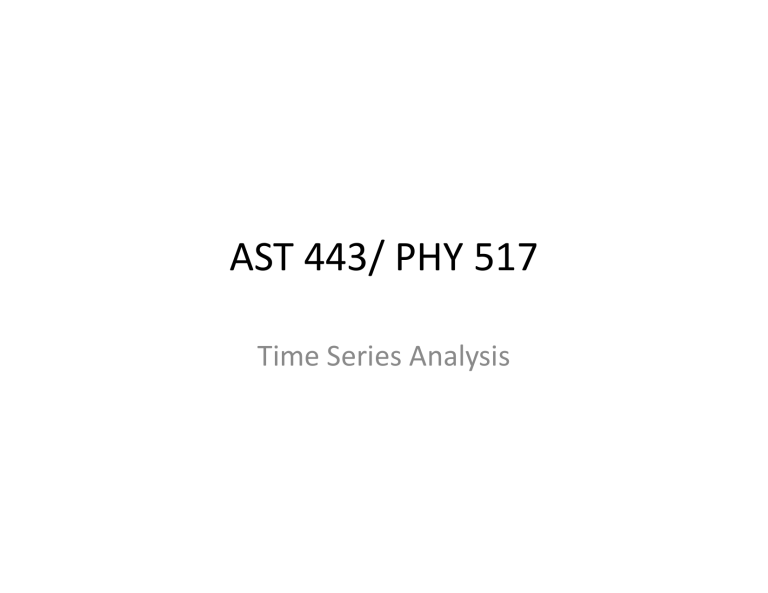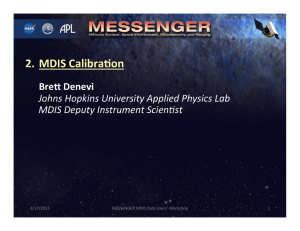Document 11143717

AST 443/ PHY 517
Time Series Analysis
First Ques;on:
Is your target variable?
Unbinned data:
• Determine photon arrival ;mes t i
• Mean CR = N cts
/(t max
-‐t min
)
• Null hypothesis: mt i
=Mean CR * i
• Use Kolmogorov-‐Smirnov test
– D=max(|t i
-‐mt i
|)
• Determine α value for D
First Ques;on:
Is your target variable?
Binned data:
• Determine count rates t i and uncertain;es σ i
• Null hypothesis: Mean CR = N cts
/(t max
-‐t min
)
• Use χ 2 test
• χ 2 = 1/(n-‐1) Σ[(t i
-‐mean CR) /σ i
] 2
• Determine α value for χ 2
If your target is variable…
• Does it vary periodically?
4.8 years of EF Eri
Could be…
Guess – Fold periods
Phase Dispersion Minimiza;on (PDM)
• Fold your data on the period to be tested.
• Bin the data into phase bins.
• The phase bins should be:
– wide enough so that there are a significant number (>>1) of points in each phase bin,
– narrow enough (<0.25 cycles) that you will see a varia;on.
• In each phase bin, average the data and set the error equal to the variance in the bin.
• Vary the period, and find the minimum χ 2
Stellingwerf, R.F. 1978, ApJ, 224, 953
Shortest String
• Fold the data.
• Order the points by phase.
• Draw a line from the first point through each point in phase order.
• Determine the length of the line.
• This length will be mimimized when the data are most correlated -‐ i.e., when you have the period.
• Advantages:
– the data need not be binned
– works with sparser data sets than the χ 2 method
• Dworetsky, M.M. 1983, MNRAS, 203, 917
Shortest String method
Shortest String: all data
Shortest String: zoomed in
All data folded
Fourier Methods
• The Discrete Fourier Transform (DFT) is a deconvolu;on of a data set into a sum of terms
A n sin(L/n), where:
– L is the length of the set and
– n is an integer.
– A n
is the amplitude of the sinusoidal term at frequency n.
• The Fast Fourier Transform (FFT) is an algorithm that can be used to generate these coefficients
A n
.
Fourier examples: Ideal case
• Input sinusoid period: 10 * 2 π points
• Frequency: 0.1 cycles/per 2 π points.
• Upper panel: the Fourier amplitudes as a func;on of frequency, from the IDL FFT procedure.
– 1/f = 10:
the input frequency
– 1/f = 0:
(infinite frequency)
the mean amplitude.
Fourier examples: Less than ideal case
• Input sinusoid period: 10 * 2 π points
• Frequency: 0.1 cycles/per 2 π points.
• Poisson noise added.
• Upper panel: the Fourier amplitudes as a func;on of frequency
– 1/f = 10:
the input frequency
is recovered!
Two Sinusoids
• Input frequencies = 5, 10
• Rela;ve amplitudes: 5:1
• FFT analysis recovers two periods
(noise is mostly
roundoff error)
Two Sinusoids + noise
• Input frequencies = 5, 10
• FFT analysis recovers only the dominant period
Fourier Techniques
• Best for con;nuous data sets
• Most sensi;ve to sinusoidal varia;ons
• For non-‐sinusoidal varia;ons, some power will be diverted into sidelobes
The Lomb-‐Scargle Periodogram
Periodograms:
• data are weighted by points, not by ;me intervals
• more appropriate than FFTs for discretely sampled data.
Scargle, J.D. 1982, ApJ, 263, 835
Horne, K. & Baliunas, S. 1986, MNRAS, 302, 757
The Lomb-‐Scargle Periodogram
The power I as a func;on of frequency ω is given by:
• I(ω) = 1/2 [ (∑ X(t
(∑ X(t i
) sin ω(t i i
) cos ω(t i
-‐τ)) 2 /∑ cos 2 ω(t
-‐τ)) 2 /∑ sin 2 ω(t i
-‐τ))] i
-‐τ)) +
• τ is defined by
tan(2ωτ) = (∑ sin 2ωt i
)/(∑ cos 2ωt i
)
• the sum ∑ is over the N points X(t i
) at ;mes t i
Fourier search in EF Eri
Zooming in…
Got it!
All data folded
Period Search Caveats. I
• You cannot find a period longer than your sampling range.
– You need at least 2 complete periods (though 1.5 can be convincing)
• You cannot find a period shorter than your shortest sampling interval.
– The frequency cannot exceed the Nyquist, or sampling, frequency.
– There are an infinite number of shorter periods that can fit your data exactly!
• Aliasing is o~en a problem.
– Observa;ons taken from one site on the Earth o~en show a 1 day period, because the data are always taken at night.
– The period will be one sidereal day if the object is always observed when overhead.
– Observa;ons taken from spacecra~ in low earth orbit suffer from a
90-‐100 minute alias.
Period Search Caveats. II
• In all cases, some of the power appears in the harmonics of the true frequency, ωN, where
– ω is the true frequency
– N is an integer.
• If there is aliasing, there will be bea;ng between the true period and the alias, giving power at 1/(1/P ± 1/A), where
– P is the true period
– A is the alias period.
Period Search Details:
The Heliocentric Correc;on
All ;ming analyses are affected by the finite speed of light
• As the Earth orbits the Sun, your distance to the target varies by ±1AU sin b
• The light travel ;me varies by ±16 minutes
• If the period of your object is comparable to this, you must correct for this geometric effect
• Δt = -‐T cos(λ
– λ o o
-‐ λ) cos(b) where
is the eclip;c longitude of the Sun
– (λ, b) are the eclip;c coordinates of the source
– T is the light travel ;me across the Earth's orbit (8.3 min).
Period Search Details:
The Barycentric Correc;on
• The heliocentric correc;on corrects to the center of the Sun for a circular orbit. This is good enough to the light crossing ;me of the
Sun (2.3 sec)
• The Barycenter of the solar system moves in a more complex manner. Us this if you need more precise correc;ons (to nanoseconds)
• For very short periods, as in pulsars, small effects are important.
– The light travel ;me across the Earth is about 40 msec.
– A spacecra~ in low Earth orbit moves about this distance in 45 minutes.
– The pulse profile of msec pulsar will be hopelessly smeared out over a few hour observa;on from an Earth-‐based telescope unless the arrival
;mes can be corrected for.







